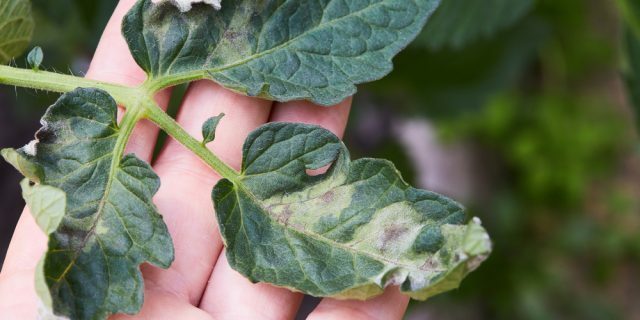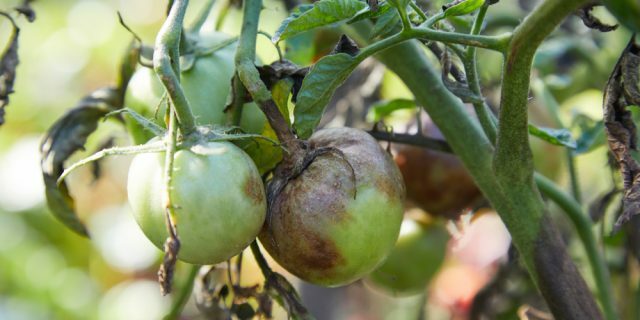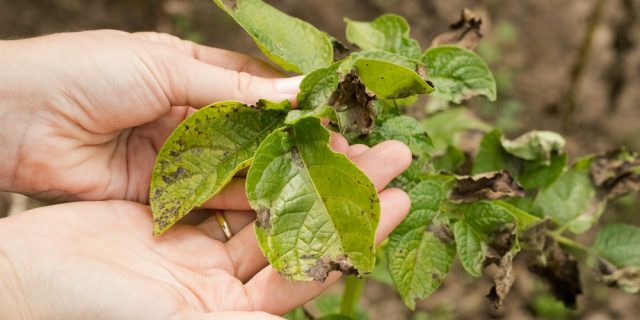How to deal with late blight on tomatoes, potatoes and other plants
Miscellaneous / / August 09, 2022
We save the harvest with effective folk remedies and special preparations.
What is dangerous phytophthora
The culprits of this disease are fungi living in the soil. They actively reproduce and capture plants - most often tomatoes, potatoes and eggplants. Waterlogged soil, foggy nights and cool weather contribute to the intensive development of phytophthora. It can also appear if you overdo it with nitrogen fertilizers. In overfed plants, immunity weakens and they cannot fully resist fungi.
How to understand what is late blight on plants

1 / 0
Phytophthora on tomato leaves. Photo: krolya25 / Shutterstock

2 / 0
Phytophthora on tomato fruits. Photo: krolya25 / Shutterstock

3 / 0
Potato affected by phytophthora. Photo: Elena Masiutkina / Shutterstock

4 / 0
Eggplant affected by phytophthora. Photo: Susilo Prambanan / Shutterstock
Phytophthora is easy to calculate. First, brown spots and a white coating appear on the leaves, and a little later they turn completely yellow and dry. The stems may also darken. The disease does not spare the fruits:
green tomatoes start to fade quickly. Sooner or later, plants die if measures are not taken to combat phytophthora.What to do before processing
Leaves and fruits affected by phytophthora should be removed without pity. You should not throw them into the compost pit: there the fungi will begin to develop successfully, and as a result, along with valuable fertilizer you will bring the disease to healthy beds. It is better to send the affected parts of the plant to the trash or burn.
After sanitary pruning, do not forget to wipe the secateurs or scissors with a disinfectant so that you do not infect other inhabitants of your garden during subsequent use.
In addition, try to water the plants early in the morning so that the soil has time to dry out during the day and does not remain too wet at night - this will deprive the phytophthora of favorable conditions for development.
How to deal with phytophthora
Folk remedies are effective at the first signs of the disease - when the spots only appeared on the lower leaves. If late blight has hit a lot of tops or even spread to fruits, it is better to use special preparations.
How to treat tomatoes and other plants from phytophthora with yeast
Take 100 g of fresh yeast or 35 g of dry yeast and dilute it in 1 liter of warm, but not hot, milk or whey. Let the solution brew at room temperature for 5 hours - during this time, beneficial fungi will start the fermentation process. Thoroughly spray the plants and soil with the resulting mixture, and you can even water them with the rest. In total, you need to carry out three treatments with an interval of 10 days.
How to get rid of late blight on tomatoes and other plants with iodine
In 9 liters of water, dilute 1 liter of whey or skim milk and 50 drops of iodine. With this solution, carefully spray the plants, fruits and soil in the garden. Iodine treatments should be carried out every 10 days until the moment of collection harvest.
How to deal with late blight on tomatoes and other plants with soda
Dilute 3 tablespoons of baking soda in 10 liters of water. You can add 20 g of liquid soap - this will help the solution stick better to the leaves. Spray plants and the soil around them every 7-10 days until the end of the season.
How to treat plants from phytophthora with garlic and potassium permanganate
Grind 100 g of garlic in a blender, pour the gruel with a glass of water at room temperature and leave to infuse for a day. Then dilute the garlic mixture in 10 liters of water and add 1 g of potassium permanganate. Spray plants and soil with this solution every 10 days until the end of the season.
How to get rid of phytophthora with the help of special preparations
Special funds - fungicides - are considered the most effective for combating late blight. In stores, you can find many drugs that, in combination, will protect plants from other fungi that cause diseases. For example, chemical agents "Skor", "Thanos", "Revus Top", "Coronet", "Tridex (Pennkotseb)" or biological - "Fitosporin" and "Trichodermin".
Before using the drug, carefully read the instructions - each has its own consumption rates and frequency of treatments. In addition, it is better to spray plants with special equipment early in the morning or in the evening at sunset so that the solution does not burn the leaves.
Read also🐞🕷🐛
- How to get rid of the Colorado potato beetle
- How to get rid of spider mites on cucumbers
- How to get rid of a wireworm
- How to get rid of aphids with store or folk remedies
- How to get rid of snakes in the area so that no one gets hurt
What to buy to take care of the car body yourself: 11 essential items
Best deals of the week: discounts from AliExpress, LitRes, Yves Rocher and other stores

